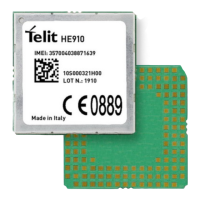
Do you have a question about the Telit Wireless Solutions HE910 and is the answer not in the manual?
| Manufacturer | Telit Wireless Solutions |
|---|---|
| Model | HE910 |
| Operating Temperature | -40°C to +85°C |
| Voice Support | Yes |
| GPS | Yes |
| Form Factor | LGA |
| Technology | HSPA+ |
| Frequency Bands | 850/900/1800/1900 MHz |
| Data Rate (Downlink) | Up to 21 Mbps (HSPA+) |
| Data Rate (Uplink) | Up to 5.76 Mbps (HSPA+) |
| Interface | UART, USB 2.0, GPIO, I2C, SPI |
| Certifications | CE, FCC, GCF, PTCRB, IC |
| Data Rates | HSPA+: Up to 21 Mbps downlink, 5.76 Mbps uplink |
Defines the purpose and scope of the hardware user guide for the HE910 module.
Identifies the intended audience for this document, primarily Telit customers and integrators.
Provides contact information and support channels for technical assistance and documentation errors.
Explains the different types of notes (Danger, Caution, Tip) and conventions used in the document.
Lists other relevant documents and application notes for further information on HE910 module features.
Details the pin assignments and functions for the HE910 module's various interfaces and signals.
Explains the procedure and circuit requirements for powering on the HE910 module.
Describes the methods for powering off the HE910 module, including software and hardware options.
Details the use of the HW_SHUTDOWN* line for an emergency, unconditional shutdown procedure.
Specifies the voltage and range requirements for the external power supply connecting to the module.
Lists the current consumption of the HE910 module in various operating modes and states.
Outlines the key guidelines for power supply design, including electrical, thermal, and PCB layout aspects.
Compares the different HE910 product variants based on supported frequency bands and antenna diversity.
Details the transmit output power levels for different GSM, EDGE, and WCDMA bands.
Provides the receiver sensitivity specifications for GSM and WCDMA bands.
Specifies the antenna requirements, including frequency range, bandwidth, impedance, and VSWR.
Offers guidelines for designing PCB transmission lines for GSM/WCDMA signals to ensure performance.
Details PCB layout considerations for FCC certification, focusing on transmission line design.
Lists the key performance characteristics of the HE910's GPS receiver, including sensitivity and TTFF.
Identifies the specific pads and signals related to the GPS receiver functionality.
Explains the RF front-end design of the GPS receiver, including LNA and SAW filter considerations.
Describes the USB 2.0 High Speed interface, its compliance, and supported features.
Details the signals and connections for the Serial Peripheral Interface (SPI) port.
Describes the primary asynchronous serial port (USIF0), including RS232 signals and usage.
Details the secondary asynchronous serial port (USIF1), focusing on TX and RX signals.
Explains the need and circuitry for translating between the module's 1.8V UART and RS232 levels.
Presents the electrical characteristics of the Digital Voice Interface (DVI) pins.
Specifies the logic level standards used for the General Purpose Input/Output pins.
Guides on configuring GPIO pads for input, including compatibility and buffering.
Guides on configuring GPIO pads for output, detailing their driving capabilities.
Explains how the STAT_LED pin indicates network status and call activity.
Describes the RTC bypass output for real-time clock supply and backup capacitor use.
Refers to external documentation for SIM holder implementation details.
Details the VAUX power output for supplying small devices, active when the module is powered ON.
Explains the Analog-to-Digital converter, its input range, and how to use it via AT commands.
Introduces the general considerations for mounting the HE910 module using SMT processes.
Provides details on the module's surface finishing (Ni/Au) and physical dimensions.
Shows the recommended land pattern and placement inhibit area for the HE910 on the application PCB.
Recommends stencil aperture layout and foil thickness for solder paste application.
Recommends Non-Solder Mask Defined (NSMD) type for PCB solder pads.
Details the recommended dimensions for PCB pads and pad surfaces.
Specifies lead-free solder paste (Sn/Ag/Cu) and the recommended "no clean" type.
Describes how modules are packaged in trays for SMT pick & place handling.
Details the packaging of HE910 modules on reels with carrier tape and reel dimensions.
Outlines moisture sensitivity requirements (Level 3) and handling conditions for the HE910 module.
Provides FCC and IC regulatory compliance statements, interference, and wireless notices.
Lists ANATEL homologation details and applicable HE910 variants for Brazil.